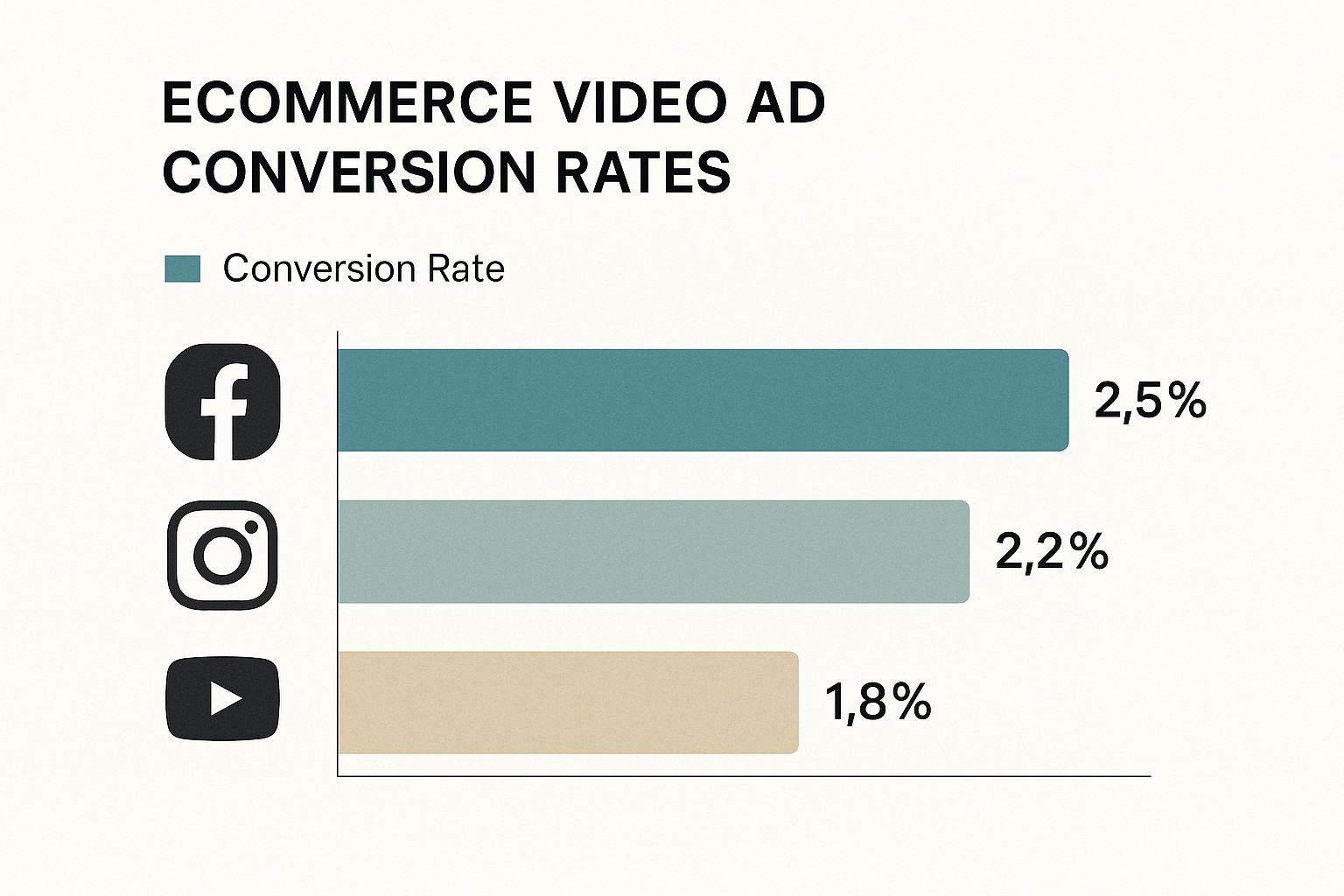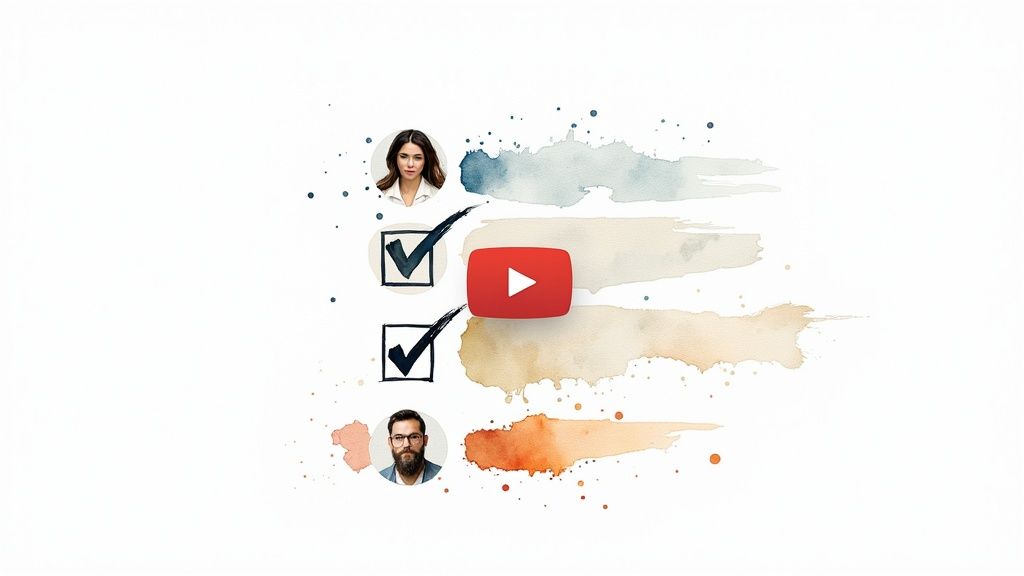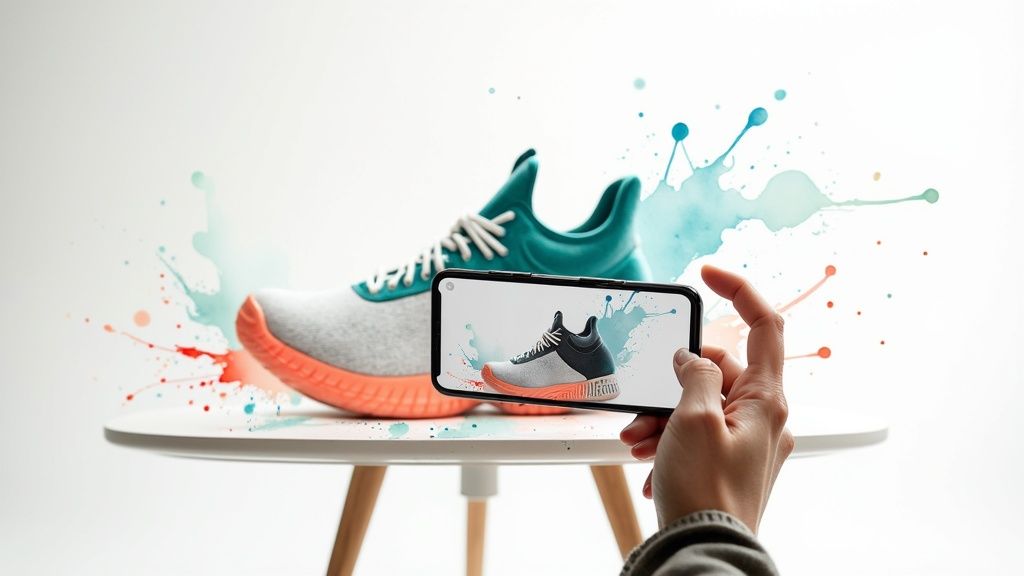Create high-converting video ads for ecommerce. This guide covers battle-tested strategies for scripting, production, and optimization to boost sales.
In This Article
Subscribe to our newsletter
Using video ads for ecommerce isn’t just a passing trend anymore—it’s a fundamental part of a smart business strategy, especially if you want to capture attention and drive real sales in a ridiculously crowded market.
When you show your product in action, you're building a level of trust and creating an emotional connection that a simple, static image just can't touch. That's how you turn casual browsers into loyal, repeat customers.
Why Your Ecommerce Store Needs Video Ads

Let's cut right to it: if you're not using video, you're leaving money on the table.
Sure, those static product photos on a clean white background are standard. But they don't tell a story. They can't show the soft texture of a cashmere sweater, the satisfying click of a well-made gadget, or the genuine smile on someone's face when they finally get to use your product.
Video ads are the bridge between the online and offline shopping experience. They let potential customers see your product from every angle, understand its real-world benefits, and actually picture it in their own lives. This goes way beyond just listing features; it’s about selling a feeling and building absolute confidence in the purchase.
Building Trust Through Visual Storytelling
In ecommerce, trust is everything. A customer can't physically touch or hold your product before they buy, so they have to rely completely on what you show them. This is where video becomes your most powerful trust-building tool.
- Authenticity: A raw, unboxing-style video or a simple customer testimonial feels far more genuine than a perfectly polished studio shot ever will.
- Transparency: How-to videos and product demos answer your customer's questions before they even think to ask them. This cuts down on purchase anxiety and shows you’ve got nothing to hide.
- Human Connection: Seeing a real person use and genuinely enjoy your product makes your brand feel relatable—less like a faceless corporation and more like a company that gets it.
This kind of visual proof is so much more convincing than a long, wordy product description. It communicates value in seconds, which is mission-critical on fast-scrolling social feeds where you have a tiny window to make an impression.
"Video gives your product a voice and personality. It transforms a simple item on a webpage into a solution, an experience, and something a customer can genuinely desire."
The Unmatched Impact on Conversions
Ultimately, every ecommerce ad has one job: drive a sale. And video consistently blows other formats out of the water in this arena. The dynamic mix of visuals, sound, and motion creates a message that's more persuasive and just plain memorable. It sticks.
The numbers back this up in a big way. The growth in video advertising for ecommerce has been absolutely massive. In fact, global digital video ad revenue is projected to jump by 19.2% from 2023 to 2024, hitting an eye-watering $62.1 billion. That makes it the fastest-growing ad format out there, proving just how crucial it is for influencing online buying decisions. You can dig deeper into these powerful video marketing trends on Siege Media.
So, when you invest in video, you're not just making ads—you're creating connections. It's your single best opportunity to stop the scroll, hold someone's attention, and guide them from casual curiosity to a confident conversion with a story they can see.
Key Video Ad Performance Benchmarks
So, what does "good" look like? While every campaign is different, it helps to have some industry benchmarks in mind. This gives you a starting point for setting realistic goals and understanding what the data is telling you.
| Metric | Industry Benchmark | What It Indicates |
|---|---|---|
| View-Through Rate (VTR) | 15-35% | The percentage of people who watched your entire video. A high VTR means your creative is engaging. |
| Click-Through Rate (CTR) | 1-3% | The percentage of viewers who clicked your ad's link. This measures how compelling your call-to-action is. |
| Cost Per Click (CPC) | $1.50 - $3.00 | How much you pay for each click. Lower is better, but it must be balanced with conversion quality. |
| Conversion Rate | 1-2% | The percentage of clicks that result in a sale. This is the ultimate measure of your ad's effectiveness. |
| Return on Ad Spend (ROAS) | 3:1 to 5:1 | The revenue generated for every dollar spent on advertising. A 4:1 ROAS means you made $4 for every $1 spent. |
Keep these numbers in your back pocket as you start to analyze your own campaign performance. They’ll help you spot what’s working and where you might need to make a few tweaks to get the best possible results.
Building Your Ecommerce Video Ad Strategy
A knockout video ad doesn't just happen. It's the product of a sharp, focused strategy. Before you even start thinking about scripts or cameras, you need a solid game plan. This blueprint is what separates the campaigns that make a real impact from the ones that just burn through your budget. It all boils down to knowing exactly what you want to accomplish.
Jumping into video creation without a clear goal is like setting off on a road trip with no destination in mind—you’ll spend a lot of money on gas and end up nowhere.
Are you trying to drive immediate sales for a new product launch? Maybe you're looking to build an email list before a big promotion. Or is the goal bigger, like getting your brand name out there in a new market? Each of these goals demands a completely different kind of video ad.
For instance, a direct-response ad pushing for sales needs a punchy call-to-action and a real sense of urgency. But an ad built for brand awareness? That’s all about storytelling and creating an emotional connection, with a much softer sell.
Defining Your Campaign Objectives
Vague goals like "get more sales" won't cut it. You have to be specific, and you have to be able to measure it. When you set clear objectives from the get-go, you can actually see what’s working and make smart tweaks along the way.
Here are a few of the most common goals we see for e-commerce video ads:
- Direct Conversions: This is the big one. It's all about getting people to buy a specific product, right now. You’ll be glued to metrics like Return on Ad Spend (ROAS) and Cost Per Acquisition (CPA).
- Lead Generation: A perfect play for higher-priced items or subscription boxes. The idea is to capture an email in exchange for something valuable, like a discount code or an exclusive guide. Here, your key metric is Cost Per Lead (CPL).
- Brand Awareness: This is a top-of-funnel play, designed to introduce your brand to people who've never heard of you. Success isn't about immediate sales; it’s measured by reach, impressions, and how much of your video people are actually watching.
Pick one primary objective for each campaign. Trying to make one video do everything—sell, generate leads, and build your brand—is a recipe for accomplishing nothing at all. Focus is your friend.
Pinpointing Your Target Audience
Once you know your "what," it's time to figure out your "who." Trying to create an ad for "everyone" is the fastest way to connect with no one. The best video ads for ecommerce feel personal, like they're speaking directly to one individual about their specific needs and desires.
Go way beyond basic demographics like age and location. You need to get into the psychographics. What are their biggest headaches? What do they secretly wish for? What kind of humor actually makes them laugh?
Answering these questions is how you craft a message that truly hits home. For a deeper look at this process, check out our guide on how to build a video content strategy to boost engagement.
Choosing the Right Advertising Platforms
The last piece of the strategy puzzle is deciding where your ad is going to run. Don't just blast it everywhere. You need to be strategic and pick the channels where your target audience actually hangs out and is open to hearing from brands. Any successful campaign starts with thoughtful planning social media strategy.
Every platform has its own vibe, its own rules, and its own ad formats.
| Platform | Best For | Audience Mindset | Key Ad Formats |
|---|---|---|---|
| Meta (Facebook & Instagram) | Broad targeting, direct-response, and powerful retargeting. It's a powerhouse for almost any product type. | Passive scrolling, discovery, and social connection. People are open to impulse buys. | In-Feed Videos, Stories, Reels Ads. |
| TikTok | Hitting Gen Z and younger millennials with authentic, entertaining, and trend-driven content. | Actively seeking entertainment. They want short, creative, and engaging videos, not stale ads. | In-Feed Ads, TopView, Branded Hashtag Challenges. |
| YouTube | In-depth product education, brand storytelling, and reaching people with high purchase intent. | Intent-based viewing. Users are actively searching for answers, reviews, or how-to's. | Skippable In-Stream Ads, Bumper Ads. |
Picking a platform isn't just about chasing the largest audience; it's about context. A quirky, user-generated-style video could crush it on TikTok but feel totally out of place as a pre-roll ad on YouTube. When you align your goal, your audience, and your platform, you're setting your video ad up for success before you ever press record.
Scripting Ads That Stop the Scroll

This is where the rubber meets the road—where your brilliant strategy gets translated into a story that sells. A killer script is the absolute backbone of any video ad that hopes to do more than just get views. It needs to drive action.
Forget about cookie-cutter templates. Your real mission is to write a narrative that grabs someone by the collar in the first three seconds of their endless scroll and doesn't let go.
Think about it: in a chaotic social feed, your ad is an interruption. You have to earn that attention by immediately answering the viewer’s silent question: "What's in it for me?" That means leading with a hook that's visually jarring, emotionally powerful, or just plain fascinating.
The Anatomy of a High-Converting Script
A script that actually converts isn't just a list of product features. It’s a mini-journey that takes a viewer from a problem they know all too well to a solution they suddenly can't live without. This is where classic storytelling frameworks are your best friend, even for a quick 15-second spot.
One of the most powerful and reliable frameworks for e-commerce video ads is Problem-Agitate-Solve (PAS). It's direct, it's psychologically potent, and it just works.
- Problem: Kick things off by hitting on a pain point your audience feels deeply. An instant connection is formed. Think of a skincare ad showing someone’s genuine frustration with a breakout.
- Agitate: Now, don't just state the problem—pour a little salt on the wound. Dial up the frustration, the inconvenience, or the emotional toll it takes. This is what builds the urgent desire for a fix.
- Solve: This is your hero moment. Sweep in with your product as the obvious, elegant solution to that agitated problem. Show the transformation—the relief, the joy, the "aha!" moment your product delivers.
A great script focuses on the transformation, not just the transaction. Customers don't buy a mattress; they buy a perfect night's sleep. They don't buy a cleaning product; they buy a spotless, stress-free home.
Writing for Both the Eyes and Ears
Here’s a hard truth: most people watch videos on social media with the sound off. That single fact should completely change how you approach scripting. Your message has to land visually before it ever lands audibly.
This means your script is really a blueprint for the visuals. Use big, bold text overlays, dynamic captions, and unmissable visual cues to walk the viewer through the story. The words on the screen should add to the action, not just parrot what’s being said. As you craft these stories, remember that each platform has its own rhythm. Brushing up on short-form video ad best practices for platforms like TikTok and Reels will give you a serious edge.
When you do write for audio, keep it simple and conversational. Seriously, read it out loud. Does it sound like a person talking, or a corporate robot? Real, authentic language wins every time.
From Script to Visual Journey
Let's make this tangible. Imagine we're scripting an ad for a fictional brand that sells ultra-durable, stain-resistant kids' clothes.
The Script Breakdown (PAS Framework):
| Scene | Visual Action | On-Screen Text | Voiceover (Optional) |
|---|---|---|---|
| Problem | A close-up shot: a child spills bright red juice all over a brand-new white shirt. The parent’s face is pure stress. | "Another outfit ruined?" | "Tired of stubborn stains?" |
| Agitate | Quick cuts: a mountain of stained clothes, a parent scrubbing furiously at a tiny spot, laundry baskets overflowing. | "Laundry day is EVERY day." | "The endless cycle of soaking and scrubbing..." |
| Solve | The same juice spill happens again, but this time on our shirt. The liquid beads up and rolls right off. A quick, satisfying wipe is all it takes. | "Not anymore." | "Meet the shirt that repels mess." |
| CTA | The kid is now playing freely, covered in mud but the shirt is spotless. Clear shot of the product and logo. | "Playtime-Proof. Shop Now." | "More play, less laundry. Shop the collection." |
This script works because it's relatable, visually proves the product’s value, and solves a real-world problem in just a few seconds. Mastering storytelling like this is one of the key ecommerce video marketing secrets that drive real sales. When you anchor your ad in a clear narrative and design it for how people actually watch videos, you create something that truly inspires them to act.
Producing High-Impact Videos on a Budget
Let's kill a myth right now: you absolutely do not need a Hollywood-sized budget or a full film crew to create video ads for ecommerce that actually work. I’ve seen it time and time again—authenticity consistently outperforms high-gloss production. Your smartphone is more than capable of creating ads that genuinely connect with viewers and drive sales.
It’s all about being resourceful, not rich.
The real key to solid DIY production is nailing the fundamentals that make a video feel professional, even if you shot it in your living room. Clean audio and good lighting are non-negotiable, but getting them right is way simpler than you might think. You don't need a truckload of expensive gear; you just need to know how to maximize what you already have.
Mastering the DIY Production Essentials
Honestly, your smartphone is the most powerful tool in your entire production arsenal. Modern phone cameras shoot in stunning 4K, which is more than enough resolution for any social media platform. The secret isn't a better camera; it's about controlling the environment around the camera.
First up, let’s talk sound. I can tell you from experience that viewers will forgive slightly grainy video, but they will immediately swipe away from an ad with muffled, echoey, or distorted audio. Using your phone's built-in mic is a gamble because it picks up every single background noise. A simple, affordable lavalier microphone that clips onto your shirt can make your audio 10 times clearer and instantly boost your production value.
Next is lighting. You can forget about complex three-point lighting kits. Your best and cheapest light source is right outside: the sun. Just position yourself facing a large window to get soft, flattering, and natural light on your face and your product. Whatever you do, avoid standing with the window behind you—it’ll turn you into a dark silhouette. If natural light isn’t an option, a simple ring light will give you consistent, even lighting for less than $50.
"The most successful budget video ads feel real because they are. They prioritize clear communication and authenticity over cinematic perfection, which is exactly what builds trust with today's savvy online shoppers."
Shooting Styles That Convert Without High Costs
Different ad styles serve different purposes, and thankfully, many of the most effective ones are inherently budget-friendly. Instead of trying to replicate a polished TV commercial, lean into formats that feel native to social media feeds.
- User-Generated Content (UGC): This is the gold standard for authentic social proof. These are videos made by real customers, not actors, so they feel genuine, build instant trust, and blend seamlessly into a user's feed. You can encourage customers to create content, but using a dedicated platform to source specific UGC videos is often a more direct and cost-effective way to get exactly what you need.
- Simple Product Demos: Forget the fancy studios. A clean, uncluttered background is all you need. Grab a tripod to keep your phone steady and create a short video showing your product in action. Just focus on highlighting the one key feature or benefit that solves a major pain point for your customer.
- Founder-to-Camera Videos: People buy from people, not faceless brands. A straightforward video of you, the founder, speaking passionately about your product and its mission can forge a powerful connection. It makes your brand feel human, relatable, and accessible.
Choosing the right format often depends on your campaign goals and the platform you're targeting. Some styles just perform better in certain environments.
Video Ad Format Comparison for Ecommerce
Here’s a quick breakdown of different video ad formats to help you decide which style best fits your campaign goals and target platform.
| Ad Format | Best For | Key Platforms | Production Tips |
|---|---|---|---|
| UGC-Style Ads | Building social proof, increasing trust, and achieving a native feel. | TikTok, Instagram Reels, Facebook | Encourage authenticity. Avoid over-editing. Use creators who genuinely match your customer persona. |
| Product Demos | Showcasing key features and benefits in a clear, direct way. | YouTube, Facebook, Instagram Stories | Keep it short and focused. Use a clean background and good lighting. A tripod is a must for steady shots. |
| Founder-to-Camera | Creating a personal connection and communicating brand values. | LinkedIn, Facebook, Instagram | Speak from the heart, not a script. Look directly at the camera to build rapport. Keep the background professional but not sterile. |
| Animated Explainers | Breaking down complex products or services in a simple, visual way. | YouTube, Website Landing Pages | Use a tool like Canva or hire a freelancer. Keep animations clean and on-brand. Focus on a clear narrative. |
| Unboxing Videos | Generating excitement and showing the customer experience. | YouTube, Instagram Reels, TikTok | Capture the genuine excitement. Show the packaging and the product reveal. It’s all about the first impression. |
This table should give you a starting point for matching your creative idea to the right execution and platform, ensuring your message lands effectively.
The infographic below shows a comparison of conversion rates for video ads on major ecommerce platforms, which can help guide where you focus your efforts for the best results.

This data backs up what we often see in practice: platforms like Facebook and Instagram, where authentic and lo-fi video styles thrive, also deliver strong conversion rates for ecommerce brands.
Polishing Your Video in Post-Production
Editing is where you take all that raw footage and shape it into a compelling story. This stage is less about flashy special effects and more about pacing and clarity. The main goal is to keep the viewer engaged and make sure your message is understood, even with the sound off.
Dynamic text overlays are your most valuable tool here. Use them to emphasize key points, call out benefits, and guide the viewer’s attention. Make your text big, bold, and easy to read on a small mobile screen. This visual reinforcement is crucial, since a huge majority of users watch videos on social feeds without sound.
Finally, always add captions. This isn’t just about accessibility; it’s about ensuring your message lands with that sound-off majority. Many user-friendly video editing apps, like CapCut or InShot, can auto-generate captions for you, saving a massive amount of time.
The brain processes visual information 60,000 times faster than text, and video's dominance is only growing—projections show it will account for 82% of all internet traffic by 2025. You can discover more insights about these video marketing statistics on Teleprompter.com.
By focusing on these simple production and editing techniques, you can create high-impact video ads that look great, connect with your audience, and drive serious results for your ecommerce store—all without breaking the bank.
Launching and Distributing Your Video Ads
So you’ve created a fantastic video ad. That’s a huge win, but honestly, it’s only half the battle. An incredible ad that nobody ever sees is just a file taking up space on your hard drive. Now the real work begins: getting that ad in front of the right people, at the right time.
This is the part where your creative project turns into a revenue-driving machine. The goal isn’t just to rack up views; it's about getting those views from people who are genuinely likely to pull out their wallets and become customers.
Choosing Your Core Platforms
While you can run ads just about anywhere these days, the big three for e-commerce are still Meta (Facebook & Instagram), TikTok, and YouTube. Each one has its own vibe and user base, so trying a one-size-fits-all approach is a surefire way to burn through your ad budget with nothing to show for it.
- Meta (Facebook & Instagram): This is the undisputed powerhouse for direct-response advertising. The targeting is incredibly granular, letting you dial in on specific demographics, interests, and even online behaviors. It's the go-to for driving immediate sales.
- TikTok: This platform is all about authentic, entertaining content that hooks younger audiences. It’s built for discovery, so ads that feel native to the platform and jump on current trends can go viral, driving massive brand awareness.
- YouTube: This is where you connect with people who have high purchase intent. Users are actively searching for reviews, how-to guides, and solutions to their problems, making it a perfect spot for longer ads that can educate and build trust.
The numbers don't lie. Advertisers spent a staggering $176 billion globally on video ads in 2023 alone. With 70% of US marketers calling social media video a 'must-buy,' you can't afford to ignore these platforms. If you want to dive deeper into the data, Shopify has some great insights on the rise of video marketing.
Building Your Audience Targeting Strategy
Solid targeting is the difference between shouting into an empty room and having a quiet, profitable conversation with your perfect customer. Don’t just scratch the surface with broad interests; you need to layer your targeting to build highly specific audience segments.
Start off with interest-based targeting to find new potential customers. Let’s say you sell sustainable yoga mats. You could target users interested in "yoga," "sustainability," and competitors like "Lululemon." This casts a wide but still relevant net.
From there, you absolutely have to implement lookalike audiences. The ad platforms can take your existing customer list or website visitor data and find brand-new users who share similar traits. This is easily one of the most powerful tools for scaling up your customer acquisition.
Retargeting is where the real money is made. It's far easier and cheaper to convert someone who already knows you than a complete stranger. Set up campaigns to show specific ads to people who have visited your site, added a product to their cart, or engaged with your social posts.
Crafting Compelling Copy and Thumbnails
Your video is the main event, but your ad copy and thumbnail are what get people to buy a ticket in the first place.
Keep your copy direct and focused on the benefits. Don't just list product features; explain how it solves a problem or makes the viewer's life better. Always include a clear and urgent call-to-action (CTA) like "Shop Now and Get 20% Off" or "Get Your Free Sample Today."
The thumbnail is your video’s first impression, and it has to stop the scroll. Go for a high-contrast image, maybe with a person's face or a really clean shot of the product in an interesting setting. The goal is to be eye-catching and intriguing. This principle applies across the board—even publishers use these tactics to grow revenue, and their lessons on engagement are invaluable. For more on that, see our guide on video ads for publishers and increasing revenue.
A Framework for A/B Testing
Never, ever assume you know what will work. The only way to truly optimize your campaigns is to test everything systematically. When you launch, have a structured A/B testing plan ready to go.
Here’s a simple framework to get you started:
- Test two different video creatives against the same audience and copy. This tells you which visual style connects best.
- Once you have a winning video, test two different ad copy variations with it. Now you're honing in on the most persuasive message.
- With the winning video and copy locked in, test two different CTAs to see which one drives the most clicks.
This methodical process takes the guesswork out of your ad strategy. You let the data make the decisions, allowing you to systematically improve performance, lower your customer acquisition costs, and maximize every single dollar you spend.
How to Measure and Optimize Your Campaigns

Launching your campaign is just the starting line, not the finish. The real magic happens when you start listening to what the data is telling you. This last part is all about reading that story correctly so you can turn a good campaign into a great, long-term profit engine.
Don't get lost in a sea of vanity metrics. The key is to cut through the noise and zero in on the key performance indicators (KPIs) that directly impact your bottom line. Everything else is secondary.
Focusing on the Ecommerce KPIs That Matter
For ecommerce brands running video ads, your success really hinges on just a handful of critical metrics. Think of these as your North Stars—they should guide every single decision you make about your budget, creative, and targeting.
Here are the essential KPIs you need to live and breathe:
- Return on Ad Spend (ROAS): This is the ultimate measure of profitability. It tells you exactly how many dollars you earn for every dollar you put into ads. A ROAS of 3:1 means you’re making $3 for every $1 spent. Simple as that.
- Cost Per Acquisition (CPA): This is your total ad spend divided by the number of new customers you brought in. Knowing your CPA is absolutely crucial for figuring out if your customer acquisition is sustainable and actually profitable.
- Click-Through Rate (CTR): This metric shows the percentage of people who clicked your ad after seeing it. While it's not a direct measure of profit, a low CTR is often the first red flag that your creative or offer isn't connecting with your audience.
These three metrics work together to give you a complete picture of your campaign's health. A high ROAS with a low CPA? You've found a winning formula.
Your ad manager dashboard is a goldmine of information, but it can also be overwhelming. Do yourself a favor and create a custom dashboard view that shows only these core ecommerce KPIs. This way, you can assess performance at a glance without getting distracted by less important data.
Navigating Your Ad Manager Dashboard
When you first open your ads manager, it's easy to feel lost. The trick is knowing where to look to find the story behind the numbers.
Start by looking at your campaign-level data to get a high-level overview. Is the overall ROAS meeting your targets?
Next, drill down into the ad set level. This is where you can compare how different audiences are performing. You might find that your lookalike audience is delivering a killer 4:1 ROAS, while your interest-based audience is only hitting 1.5:1. That insight immediately tells you where to shift your budget for better results.
Finally, analyze the individual ads within each ad set. This is where you spot creative fatigue or find your winning video. If one video has a significantly higher CTR and a lower CPA than the others, you've found your champion. To truly understand the impact of your efforts, learning how to measure advertising effectiveness is crucial for assessing your video ad campaigns.
The Optimization Loop for Long-Term Growth
Optimization isn't a one-and-done fix; it's a continuous cycle of testing, learning, and scaling. This simple loop will help you systematically improve performance and drive profitable growth with your video ads for ecommerce.
- Analyze Performance Data: Every 2-3 days, jump in and review your core KPIs. Identify the campaigns, ad sets, and ads that are underperforming and pause them. Stop the bleeding.
- Identify the Winners: Find the combinations of video creative and audience targeting that are delivering the best ROAS and CPA. These are your top performers.
- Scale What Works: Gradually increase the budget on your winning ad sets. I'm talking 15-20% every few days. This slow-and-steady approach allows the platform's algorithm to adjust without resetting the learning phase, ensuring stable growth.
- Test New Variables: Never stop testing. Duplicate your winning campaigns and test one new variable at a time—a new audience, a different video hook, or a fresh call-to-action. This is how you discover your next winning ad.
By consistently applying this optimization loop, you move from guessing what works to knowing what works. You let the data guide your decisions, refining your strategy based on real customer feedback and making sure your ad spend is always working as hard as possible to grow your business.
Common Questions About Ecommerce Video Ads
Jumping into video advertising for the first time? It's natural to have a few questions. Getting straight answers to these common sticking points is the fastest way to build a strategy that actually works and doesn't feel overwhelming.
How Long Should My Ads Be?
One of the first things brands always ask is about the perfect length for their video ads for ecommerce. While there’s no single magic number, shorter is almost always better, especially on crowded social feeds.
For platforms like Meta and TikTok, you really want to aim for under 30 seconds. The real game is to snatch attention and get your main point across in the first three seconds. If you can’t hook them by then, you’ve lost them.
Do I Need to Hire Professional Actors?
Another big one is whether you need to shell out for professional actors. The answer? A hard no.
In today's market, authenticity sells way better than a polished, high-budget production. In fact, using real customers, leaning into user-generated content (UGC), or even featuring yourself as the founder can build a ton more trust and relatability. People connect with real people.
Budgeting and First Steps
So, how much should you actually spend when you're just starting out? It's a critical question, and it can feel pretty intimidating.
Think of your initial ad spend as an investment in data, not an immediate push for profit. You're spending a small amount to learn what resonates with your audience before you go all in.
Start with a daily budget you're completely comfortable losing—maybe $20-$50 per day. Use this initial phase as a testing ground. Run different videos, try out a few audiences, and play with your ad copy.
Once you find a combination that delivers a positive Return on Ad Spend (ROAS), that’s your green light. From there, you can start inching up your budget with confidence, knowing you’re putting money behind a proven winner. This methodical approach takes the guesswork out of the equation and sets you up for profitable, long-term growth.
Ready to create high-quality, engaging videos for your ads without the high costs and long timelines? Aeon uses AI to transform your existing content into stunning, on-brand videos at scale. Discover how our platform can streamline your video production and boost your campaign performance at https://www.project-aeon.com.


.jpg)